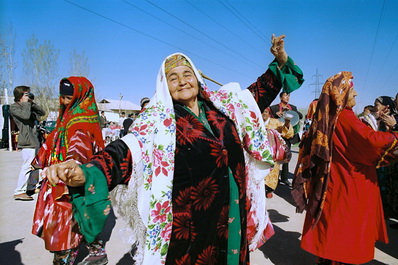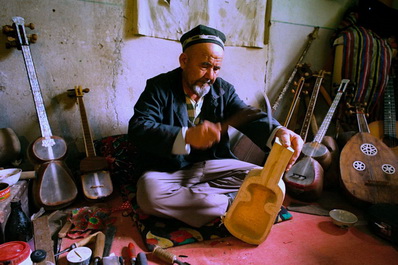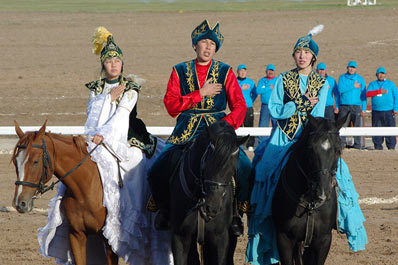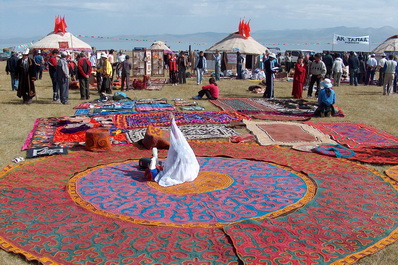Culture of Kazakhstan
Kazakh culture and national traditions
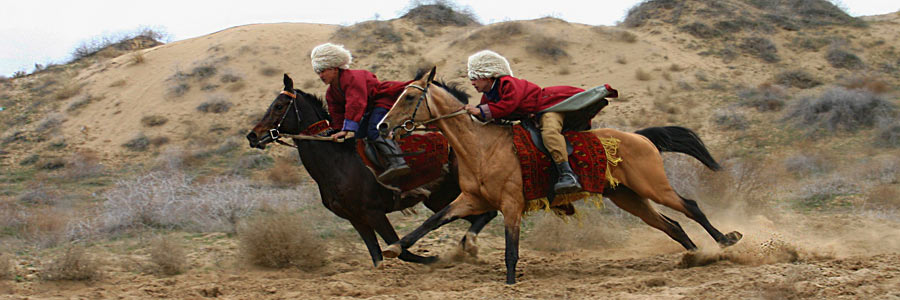
The Kazakh people are rich in traditions. From birth through old age and death, every step of their lives has historically been marked with celebration. Even their funeral ceremonies have their own special symbolism.
Unfortunately, many rich and interesting traditions and customs of the Kazakh people have been forgotten throughout the past century. Real sovereignty is just now being reestablished in Kazakhstan due to the process of democratization. These abandoned traditions are just now being rediscovered by the Kazakh people. These traditions include being respectful to old people; being patriotic to the motherland; being honest; and learning to love mankind.
Traditionally every guest is offered Kazakh cuisine at the dastarkhan (the low table) in a yurt.
Kazakh Yurt
The yurt is one of the most sensible types of movable house. It is a comfortable and practical home, ideally suited to local conditions and ways of life - one of the greatest inventions of the Eurasian nomads.
It is easily taken apart (it is said that a Kazakh woman can do it in half an hour) and carried by horses and camels. The yurt consists of three main elements: an extensible trellis base(the kerege), a dome made of poles (the uyk) and a round top(the shanyrak).
In ancient times Turks were reputed as the most skillful felt-makers. These days the Kazakhs use felt to cover the yurt and for its internal decoration, as well as to make carpets, dresses and shoes. The Kazakhs live surrounded by& ornaments. They richly decorate their yurts with wall carpets and multi-colored embroideries.
Handicrafts
Handicrafts - harnesses, felt mats (tekemets), and articles made of wood, bone and metal - are lavishly decorated. Headdresses, dresses, bags and saddle-cloths are beautifully embroidered. They use traditional designs and carvings to make and decorate the wooden cups, large bowls and ladles used to serve kumis (fermented mare's milk).
The horns of mountain rams and goats are used to decorate beds and caskets. Leather is used to make quivers, belts, harnesses and flasks (torsyks) for water and kumis. Kazakh artisans are also very skillful jewelers.
Steppe zergers(jewelers) favor white silver. Traditional Kazakh bell-shaped earrings, original bracelets (blezics), or the traditional bracelet linked to three rings with fine chains will certainly impress you.
Traditional Clothes
Kazakh national dress varies by regions. Men wear chapans, a kind of dressing gown with a belt, made of velvet and richly embroidered. They cover their heads with a soft skullcap (tobetai), a tall felt cap (kalpak) or a fox-fur hat with earflaps (malakai).
The women's national costume consists of a white cotton or colored silk dress, a velvet waistcoat with embroidery and a cap or a silk scarf. Elderly women wear a hood made of white cloth with a hole for the face (the kimeshek). Brides wear a tall pointed, richly decorated hat, topped with feathers (saukele).
Music And Musical Instruments
Kazakh music and musical instruments: The Kazakhs love the art of wordplay and their akyns (poets), who improvise at public competitions (aitys) accompanied by Kazakh stringed musical instruments: the dombra or the kobyz.
Holidays
Nauryz (Islamic New Year) is one of the biggest holidays in Central Asia. In Kazakhstan it is celebrated on the day of the spring equinox, March 22. On that day, the streets of villages and towns are transformed. Guests are hosted in beautiful yurts with the traditional Nauryz kozhe dish made of seven traditional ingredients. People respecting this nearly month-long holiday forgive each others' debts and offences.
National Games
National games: these are usually performed on horseback and are an opportunity to witness the Kazakhs' outstanding riding skills. Kazaksha kures (Kazakh wrestling), baiga (horse racing over 25, 50 or 100 km), kokpar (a sort of polo game played with a dead goat), kyz-kuu (catch the girl) and alty bakan (six-pole swing).

